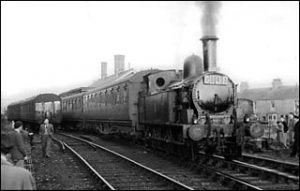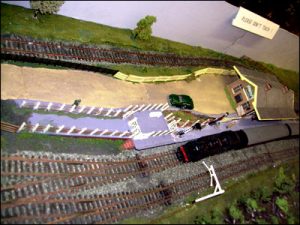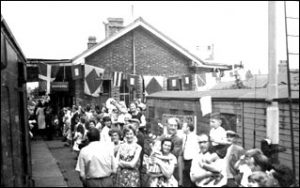Until the 1960s Newport Pagnell had a railway linking the town to Wolverton. The line became part of the London North Western network and was simply a branch line between the two towns. The line provided transport for workmen, who had employment at the railway works in Wolverton and for schoolchildren travelling to school in Wolverton. The line also brought goods from Wolverton and conveyed them from Newport Pagnell to Wolverton. This was particularly important for the mills in the town. The line was also very useful for transporting livestock; and cars and vehicles from the Salmons vehicle production works in Newport Pagnell. This car plant in the town eventually became the Aston Martin Lagonda factory.
The train, which used the line, was affectionately known as the ‘Newport Nobby’.

The Newport Nobby
It was proposed to extend the line from Newport Pagnell to Olney and beyond, but this never materialised, though there is still evidence of a start being made on the local common land called Bury Field. Newport’s line was closed during the 1960s in the frenzy to cut the number of lines said to be losing money and also as a result of the rise of road transport . (Below is an overhead photograph of a model, showing the station and area adjacent to it. You can see the cattle dock in the middle of the picture, the train in the station and the lines leading to the left of the picture down to the mills and goods yard.)

Here is a brief account of Newport’s railway history.
THE NEWPORT PAGNELL RAILWAY THE BEGINNING
After several attempts on 29th June 1863 the Newport Pagnell Railway was given the go-ahead to construct a 4 mile line from the London North Western Railway at Wolverton, purchase the Newport Pagnell Canal and make a working arrangement with the LNWR. The company was given the powers to raise a capital of £45,000 and £15,000 by loans. Work started by the August of 1864. This resulted in considerable earthworks, as much of the line was either on an embankment or in a cutting. From Linford station the railway followed the course the Newport Pagnell Canal had used. On 30th September 1865 ballast wagons full of navvies ran the length of the line. With the line almost complete there was then a problem to be solved over the use of Wolverton station. On May 8th 1866 Captain Rich inspected the line on behalf of the Board of Trade and accepted the works apart from the junction at Wolverton. On 24th July 1866 to get goods traffic underway along the line the Newport Pagnell Railway arranged for use of the LNWR station at Wolverton at a greatly reduced rental from the one originally asked for by the LNWR. Eventually the junction at Wolverton was put in order for passenger traffic. The line was then fully opened on SEPTEMBER 2ND 1867. To celebrate this momentous event the following took place: Having travelled back and forth on the train the Wolverton Brass Band marched through decorated streets to the Swan Hotel
- Rustic sports were held
- Celebrations continued until the early hours of the following morning
- Tea and tobacco were donated to all the over-sixties in the town Thereafter nearly 400 men and over 100 boys could use the workmen’s train to travel to Wolverton to their jobs. It was 1865/6 that efforts were made to push the line onto Olney, though this was never accomplished.
THE GOODS OPERATIONS AT NEWPORT PAGNELL
The goods operation was east of the station, having a siding serving a corn, cattle cake, coal and lime merchant, who was also a brick maker. With the filling in of the canal basin the goods yard was built on the resulting land. The railway was then in a position to take over the business there. However this was not as plentiful as had been hoped. South of the passenger platform were facilities to serve flour production, once served by the canal. There were 2 flour mills at Newport which had their own railway sidings connected to the branch line. Messrs Price & Goff had their own loading shed established in 1870 with its own turntable. This was all at right angles to the 2 goods sidings. Another siding did not enter the goods yard at all but diverted from the station before the platform crossing over the shed line and out of the station altogether to reach Hives & Sons building. This was taken over in 1885 by Francis Coales & Son. For the information of the working of this private siding we are indebted to John Coales words: Aston Martin cars were loaded at the carriage dock at the back of the passenger station onto a short line, which terminated in a ramp. In the days of Salmons and Sons chassis and engines were carried in special trucks brought to Newport by train. These were off-loaded and taken by horse-power to the Salmons and Sons works in Tickford Street, where the car bodies were added. Once the cars were finished, they were conveyed by train to all parts of the country. All the coal used in Newport and the surrounding villages came in by train. It was the main commodity with tonnages of 7,269 for 1874 the final complete year for the Newport Pagnell Railway. Cattle were carried from Newport. Farmers would drive their cattle from the fields along the road to the station and then put them into the station cattle pen ready to be loaded onto the cattle trucks on the trains. Normally the daily goods train was worked by a tank engine. Engines with tenders infrequently pulled goods trains on this line. It was usually in the middle of the morning when the goods train came in, and then for about an hour the engine would shunt all the goods trucks so the empty ones could be taken back. Even at the end goods trains could be handling as many as 60 wagons in a train on the branch. However, from 1966 when Bletchley closed to steam, Class 24 diesel-electrics hauled the daily freight, which was mostly coal and scrap metal. The goods operation ceased on 22nd May 1967, though the siding to Coales, that left the station and crossed the road at Newport, had been disconnected in the late 1950s. The branch line continued to serve the people of Newport Pagnell until the storm clouds gathered in the early 1960s. The line was included in the Beeching report of 1962 which concluded that, since 30% of the railway network carried less than 1% of the total passenger traffic, much of it should be closed. The residents of Newport Pagnell resisted the closure, demanding an enquiry which took place on 7 June 1964. Despite many objections, it was determined that the line would close. The last passenger service was the 5:34 pm train from Newport Pagnell on 5 September 1964, just under a century after the line opened to passengers. The mourning of the line was so great that a bucket of water was poured over a double dressed as Richard Beeching, the man commonly associated with the closure of over 4,000 miles of the British railway network. The crowd cheered as this happened, a mark of the public’s’ feelings about the closure. Once the line ceased to operate the tracks were lifted. Part of the trackbed is now used by the Milton Keynes Redway system, which is the network of cycle and pedestrian routes that serves the Milton Keynes urban area. Here is picture of Newport Pagnell railway station on the final day.

Last day of Nobby
Date opened: 2.9.1867. Location: On the north side of Broad Street. Company on opening: Newport Pagnell Railway. Date closed to passengers: 7.9.1964. Date closed completely: 22.5.1967. Company on closing: British Railways (London Midland Region).
Present state: The site is lost under Shepherds Close, a new housing development. The Newport Pagnell Railway Act was passed in 1863 and the following year the Newport Railway Company bought the short branch canal with the intention of using the route for their new railway line into Newport Pagnell.
The line did exactly follow the canal route which hugged the contours of the surrounding land. The intention was to continue the line on to the Market town of Olney and powers were granted for this extension in 1865 with a further extension to join the Northampton-Peterborough line at Wellingborough. The extensions beyond Newport Pagnell were never built with powers lapsing in 1871 although some work had been undertaken. The line was complete by 30th September 1865 when the first locomotive traversed the line. The next year the railway opened for goods, cattle and parcel traffic and on 2nd September 1867, there was the ceremonial opening of the line for passengers. There were two intermediate stations at Bradwell and Great Linford. The lines main regular passengers were employees of the Railway Works at Wolverton. The line was complete by 30th September 1865 when the first locomotive traversed the line. The next year the railway opened for goods, cattle and parcel traffic and on 2nd September 1867, there was the ceremonial opening of the line for passengers. There were two intermediate stations at Bradwell and Great Linford. The lines main regular passengers were employees of the Railway Works at Wolverton. In 1875 the line was taken over by the London & North Western Railway who had provided the service from the opening. As with many rural lines the development of road transport gradually began to erode passenger numbers. The first motor bus service was in the country was introduced between Newport Pagnell and Olney in 1898 and the popularity of the motor car through the 20th century eventually spelled the end for the line. The last passenger train ran on 7th September 1964.Goods traffic continued for three years until final closure on 22nd May 1967. The track was lifted later the same year. The platforms at Great Linford and Bradwell survive but the only evidence in Newport Pagnell is the post of the starting signal, now at the beginning of the Redway between allotments.With the expansion of Milton Keynes changing what was a rural area into well populated sprawl there have been suggestions in recent years that the line should be reinstated.
